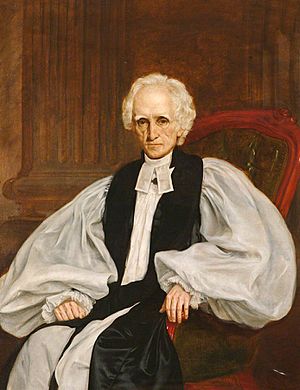Edward Stanley (bishop) facts for kids
Quick facts for kids The Right Reverend Edward Stanley |
|
|---|---|
| Bishop of Norwich | |
 |
|
| Diocese | Diocese of Norwich |
| In Office | 1837–1849 |
| Predecessor | Henry Bathurst |
| Successor | Samuel Hinds |
| Personal details | |
| Born | 1 January 1779 |
| Died | 6 September 1849 (aged 70) |
| Nationality | British |
| Denomination | Anglican |
| Spouse | Catherine Leycester |
| Alma mater | St John's College, Cambridge |
Edward Stanley (born January 1, 1779 – died September 6, 1849) was an important English church leader. He became the Bishop of Norwich in 1837 and served until 1849. He worked hard to make sure church leaders followed rules and did their jobs well.
Contents
Edward Stanley's Early Life
Edward Stanley was born in London in 1779. He came from an important family in Cheshire, England. His father was Sir John Thomas Stanley.
He studied at St John's College, Cambridge. In 1802, he became a priest. Three years later, he became the rector (head priest) of Alderley, Cheshire. He held this job for 32 years. While there, he cared a lot about education. He especially encouraged teaching everyday subjects in his school.
Becoming a Bishop
In 1837, Edward Stanley became the Bishop of Norwich. He also became the Clerk of the Closet, a special role in the royal household. He held both jobs until he died.
At that time, the Norwich church area had some problems. Rules were not always followed, and some church leaders were not doing their best. Bishop Stanley worked to fix these issues. At first, he faced some resistance.
He made sure that ordinations (making new priests) and confirmations (a church ceremony) happened more often. Schools were checked properly. He also made sure that the "Plurality Act" was followed. This law stopped priests from holding too many jobs at once. If priests were not doing their job well, he removed them.
Bishop Stanley was also very open-minded. He was kind to people who were not part of the main church (called Dissenters). He supported all missionary work, no matter which church group was doing it. In politics, he was a Liberal. He focused a lot on improving education for everyone.
Other Important Work
Bishop Stanley wrote letters that were later published as a book. It was called Before and after Waterloo. These letters are interesting for people who study the time of Napoleon.
He was also the first leader of the Ipswich Museum. He was there when it opened in 1847. You can see a painting of him at the museum today. From 1837 to 1849, he was the President of the Linnean Society. This society studies nature.
His Family
On May 8, 1810, Edward Stanley married Catherine Leycester. They had five children:
- Owen Stanley (1811–1850), a Royal Navy officer and surveyor.
- Mary Stanley (1813–1879), a nurse.
- Arthur Penrhyn Stanley (1815–1881), a priest and historian. He became the Dean of Westminster.
- Charles Edward Stanley (1819–1849), an officer in the Royal Engineers.
- Catherine Maria Stanley (1821–1899), who married Charles Vaughan.
Death and Successor
Edward Stanley passed away in 1849. He was buried in the main part of Norwich Cathedral.
After him, Samuel Hinds became the Bishop of Norwich. Samuel Hinds was known for his connections with the Maori people of New Zealand.


